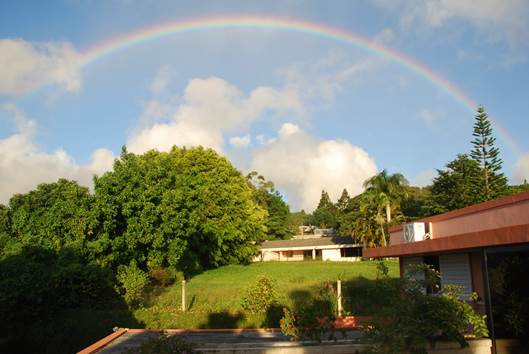How does it feel in paradise?
Climate and Weather in Mauritius

Typical afternoon clouds in the North

Rainbows can be often seen over the Central Plateau

Sunset at Le Caudan Waterfront, Port Louis
Let’s start with the obvious: The climate in Mauritius is just beautiful!
Lots of bright sunshine (7.5 to over 8.0 hours at the coastal regions throughout the year), mild temperatures, and absolutely no air pollution. When it is winter in the Northern Hemisphere, it is summer in Mauritius!
The island enjoys a mild tropical maritime climate throughout the year. It has two seasons: a warm humid summer extending from November to April and a relatively cool dry winter from June to September. October and May are transition months.
The temperature difference between the seasons is low: Mean summer temperature is 24.7 degrees Celsius and mean winter temperature is 20.4 degrees Celsius.
The warmest months are January and February with average day maximum temperature reaching 29.2 degrees Celsius and the coolest months are July and August when average night minimum temperatures drops down to 16.4 degrees Celsius.
Extreme day temperatures can reach 36 degrees Celsius on the West coast and 34 degrees in the North. The trade winds blow the most time of the year from easterly directions, bringing a soft breeze to most parts of the island. In the wind shadow of the mountains, however, it can become oppressively hot, especially in Port Louis and the West coast.
The long term mean annual rainfall over Mauritius is 2010 mm. The driest month is October. Although there is no marked rainy season, most of the rainfall occurs in summer months with February and March being the wettest months.
Microclimates
Mauritius has pronounced microclimates that vary more than you would expect. You can easily reach another climate zone within a 30 minutes car drive! Following are some rough rules that I extracted from my own experience and observations:
- Daily temperatures on the coast are often 5-6 degrees higher than over the Central Plateau.
- Nightly temperatures on the coast are up to 3-5 degrees higher than over the Central Plateau.
- The breeze is strongest in the East, in the North and in the Center, and least in the West.
- There is much more rain in the higher regions than in the lower regions. In the dry season, you might have one shower per day over the Central Plateau but only one shower per week in the West and in the far North.
- The humidity is increasing the closer you are to the low clouds. When you live in Curepipe (500-600 meters above sea level), you might need humidifiers in summer and heating in winter. Many houses in the Center do not have air condition, since high temperatures in places like Curepipe and Floréal rarely exceed 29 degrees.
- On the other hand, you definitely need aircon when you live near the coast where the night temperatures in summer do not fall below 25-26 degrees.
Cyclones
Mauritius is exposed to cyclones. Statistically, the island will be fully hit every five years. The remnants of bypassing cyclones, i.e. strong winds and torrential rains, are influencing Mauritius 3-5 times in each cyclonic season which runs from November to April.
